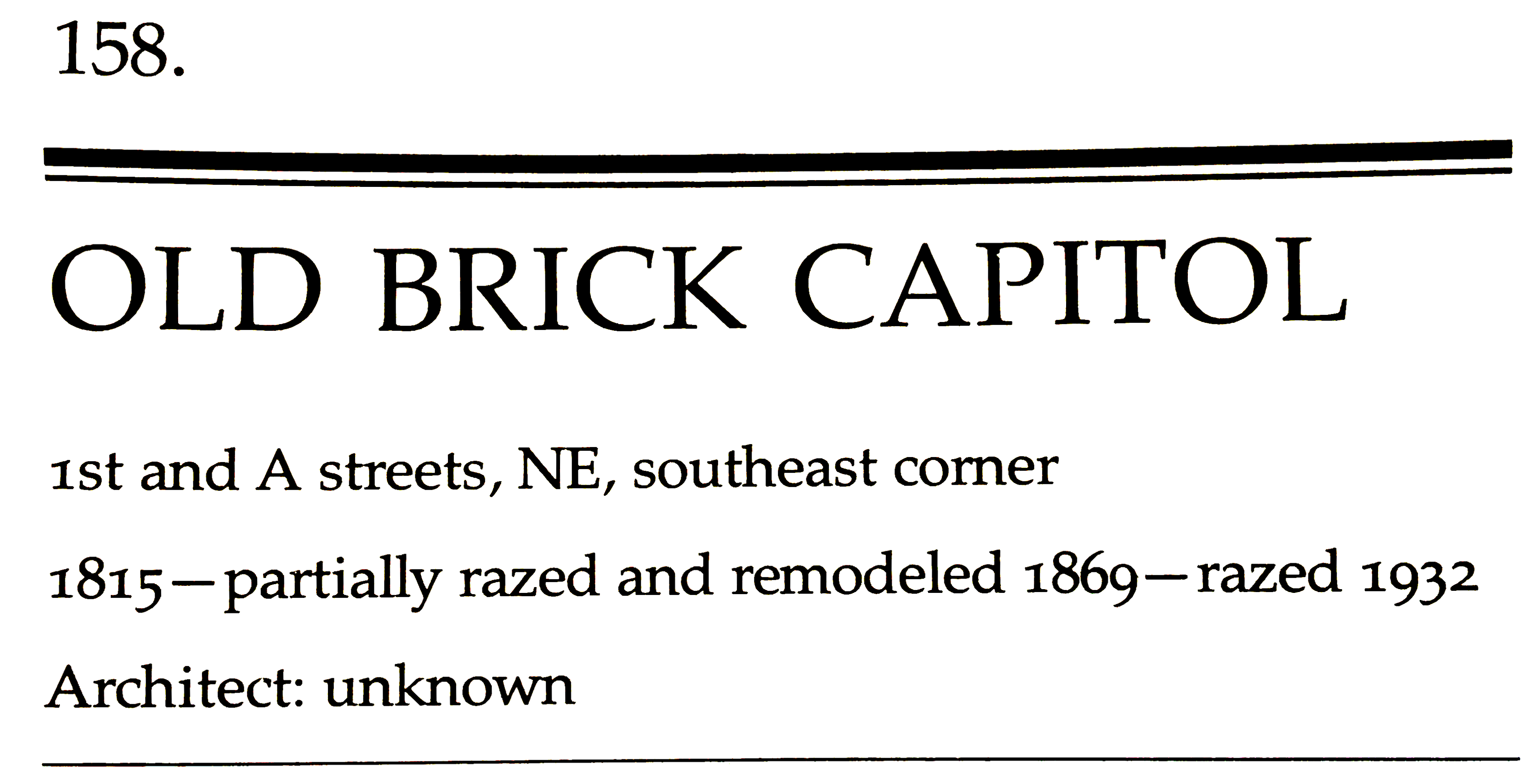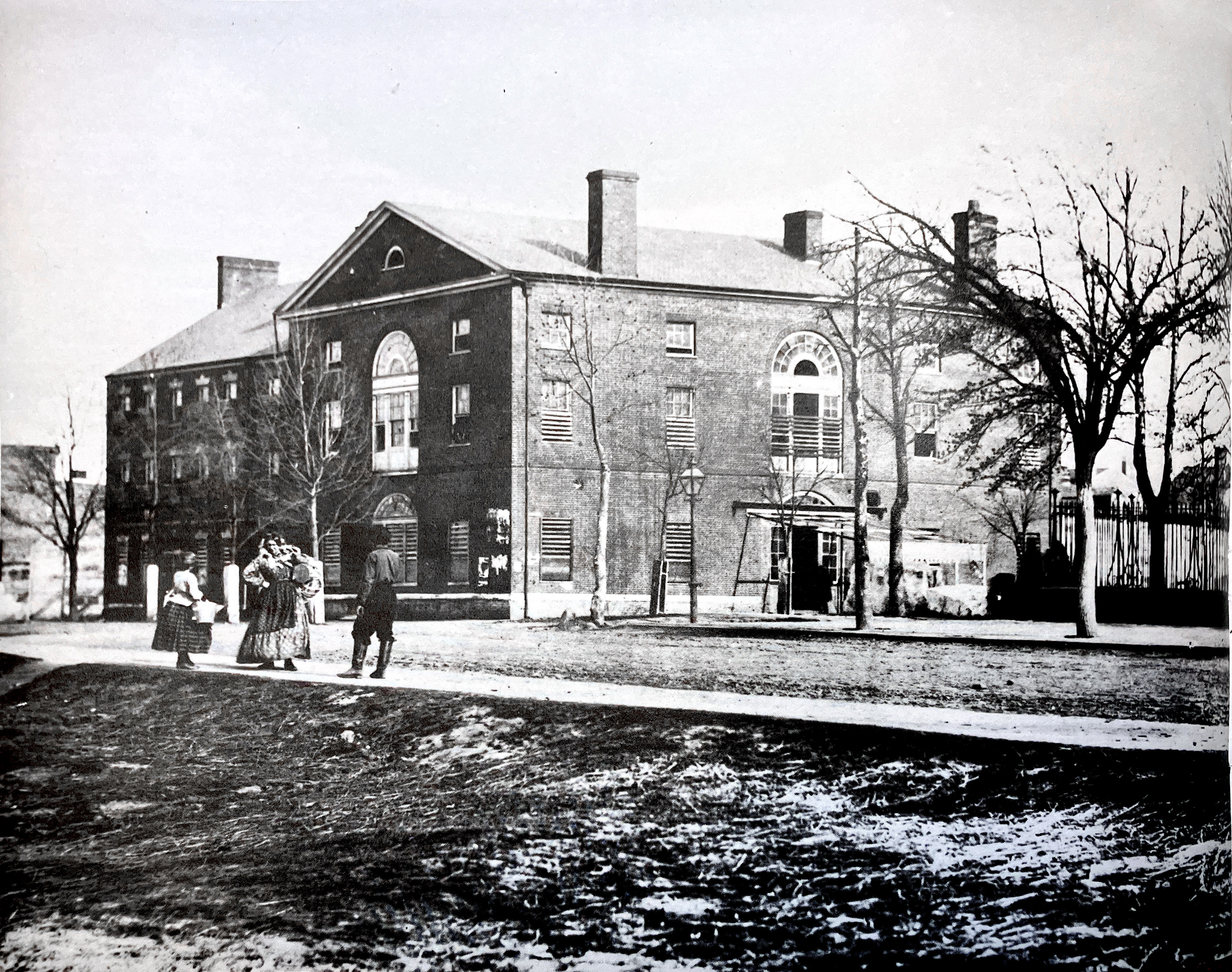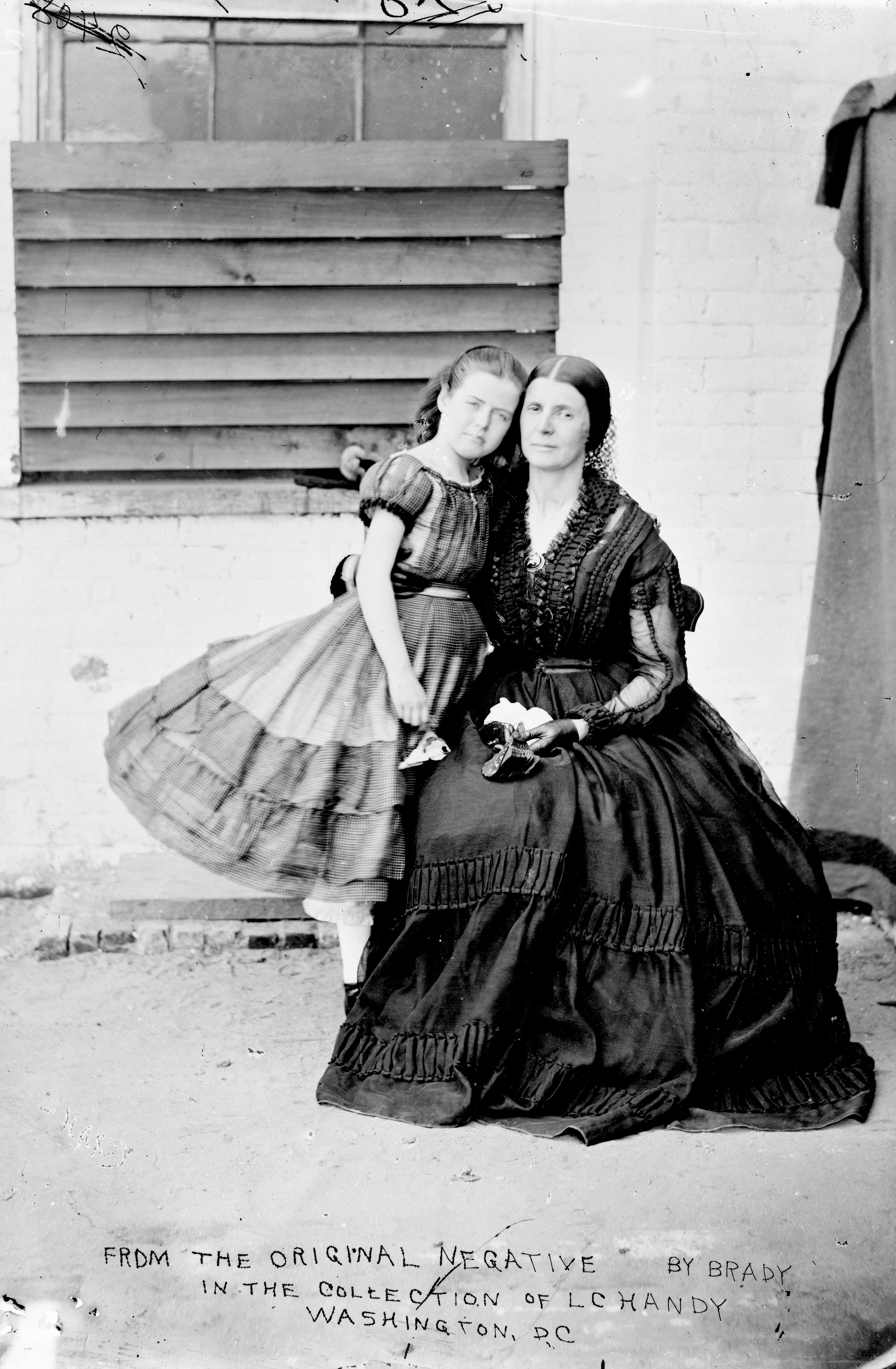
Few building sites in Washington have experienced such varied and unusual uses as the southeast corner of 1st and A Streets, NE — tavern, meeting place of Congress, prison, school, boardinghouse, home of the National Woman's Party and of the Supreme Court! The site was first used in 1795 for the location of an early Washington tavern, built by William Tunnicliff, who left it shortly afterward to manage the larger Eastern Branch Hotel (sometimes known as Tunnicliff's Tavern) on Pennsylvannia Avenue and 9th Street SE (see no. 88) For a number of years the earlier red brick hostelry, Stelle's Hotel, was managed by Pontius D. Stelle. This Elegantly managed tavern, which faced A Street, was one of the most important in the city's early years, providing not only food, drink and lodging for congressmen and diplomats, but extensive sheds in the rear for the accommodation of coaches arriving daily from Baltimore.
This eighteenth-century building was pulled down in 1815 to clear the site for a temporary meeting place for Congress after the British burned the Capitol on August 24, 1814.

The thirteenth Congress met on September 19, 1814, in the only available building in Washington — Blodgett's Hotel — which was then located at 8th and E streets, NW (present location of the United States Tariff Commission). A number of congressmen, who had always felt the move of the capital from its former cosmopolitan seat in Philadelphia to the remote and unsettled location in Washington was a mistake, openly talked of relocating the federal govemment. In response, a number of prominent Washington citizens, fearing the loss of their heavy investments in local real estate, formed a joint stock company, the “Capitol Hotel Company,” to erect a temporary home for Congress until the old Capitol could be rebuilt. In the meantime, on November 21, 1814, Congress appointed a special committee to consider one of three possible courses of action: moving the seat of government to another city, building a new Capitol at another location in Washington, or rebuilding the shell of the burned-out Capitol. Although a third of the representatives were in favor of moving the seat of government, Congress decided in February 1815 to rebuild the old Capitol, and voted funds (which were borrowed from Washington banks) to carry the project to completion. The stock company, comprised of thirty-eight local citizens, quickly purchased the old Stelle's Hotel building, demolished it, and began construction of the temporary brick Capitol on July 4, 1815. It was rushed to completion for occupation by Congress in December 1815.
The building remained the temporary home of Congress for four years. The Senate met on the first floor and the House of Representatives on the se.cond floor. The three-story Federal brick building, with a wide-arched central entrance facing 1st Street, was built at a cost of $25,000. Because of a bitter quarrel between members of the Senate and House over which chamber would be used for the inauguration of President James Monroe, the president-elect took the oath of office before a crowd of spectators outside the building on March 4,1817 thus establishing the custom in Washington of swearing-in the president in the open air.
Architect of the Capitol Charles Bulfinch managed to have the Capitol restored and furnished in time for the return of Congress in December 1819. For many years afterward the Old Capitol was used as a private school, and then for many years as a boardinghouse for congressmen. Here, the noted champion of states' rights, Sen. John C. Calhoun of South Carolina, died in his apartment on March 31, 1850, spared from seeing the Civil War he had helped to bring about.

The four tragic years of the Civil War were indeed the most eventful in the life of the Old Capitol, as it was still commonly called. The great rambling structure, whose bulk was partly relieved by the large arched central windows, which extended from the second floor through the third floor on three facades, was purchased by the federal govenunent in the spring of 1861 for use as a prison for political prisoners. The windows were disfigured by hundreds of horizontal slats of wood, both on the main building and its large temporary wooden wing, which projected to the rear along A Street. Armed sentries paced their rounds at brief intervals to prevent arms from being passed to the prisoners by the considerable portion of the Washington population who were Confederate sympathizers.
Crowded into the filthy and uncomfortable rooms by late 1861 were a strange collection of inmates—political prisoners, Union officers who had voiced opposition to the regime in power, Confederate spies, local prostitutes, contraband slaves who had fled their rebel masters, blockade runners, and a host of varied lawbreakers. The superintendent, William P. Wood, a native of Alexandria, Virginia, who was an abolitionist and and a staunch Republican, was loathed by the prisoners for his use of an elaborate system of paid informers among the inmates. Perhaps the most famous prisoner of all was the patrician Southern beauty, Mrs. Rose O'Neal Greenhow. Acting as a Confederate spy as soon as the Confederate States were formed in February 1861, she supplied information on military fortifications and the movement of Union armies. Many others, including James G. Berret, mayor of Washington, underwent similar confinement at the same time for speaking against the federal govenunent, and were eventually sent to prisons in New York harbor and elsewhere.
Soon another famous female Confederate spy, Belle Boyd, arrived at the Old Capitol Prison after her arrest in 1862 in the Shenandoah Valley. Miss Boyd loved to sing and gave concerts for the other prisoners, who listened from behind bars. Among the other prominent women prisoners was Louisa P. Buckner, the niece of the postmaster general, who was arrested by Secretary of War Edwin Stanton when she was discovered smuggling a vast amount of quinine out of Washington for use in Confederate hospitals.
After swearing never to return to the North again during the course of the war, the female prisoners were taken by steamer to Virginia and released. Mrs. Greenhow made a triumphant entry into Richmond, where she was entertained by Confederate President Jefferson Davis. The male prisoners were not so fortunate, especially the political prisoners, who were detained without redress for many months. Some were shot by guards for approaching too close to the windows, but more died from the poor diet. It was in the stockaded rear courtyard that the superintendent of Andersonville Prison, Confederate Henry Wirz, was hanged on November 10, 1865, the only man executed for war crimes.
After the war, in May 1867, the federal government sold the Old Capitol. With fmancial help from Lyman Trumbull of Illinois , George T. Brown, the sergeant-at-arms of the Senate, bought the property for $20,000. In 1869 Brown had the massive rear wing of the structure demolished, and the main section was remodelled into three large town houses in Second Empire style, with mansard roofs and appropriate Victorian doors and windows. The building was thereafter known as “Trumbull's Row.”
The three houses were eventually sold in the early twentieth century, and used as the national headquarters of the National Woman's Party (see no. 251). The Old Capitol, the scene of events both triumphant and tragic, disappeared from the Washington cityscape in the early 1930s when it was demolished for the new Supreme Court Building.
